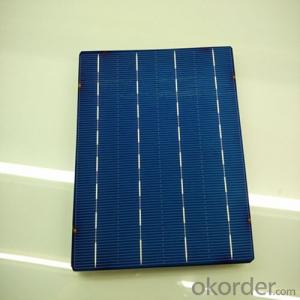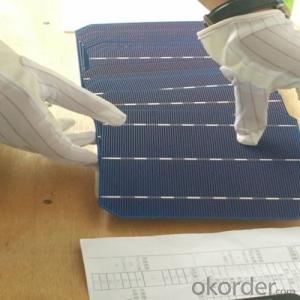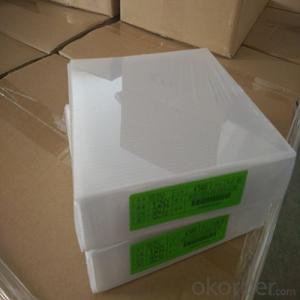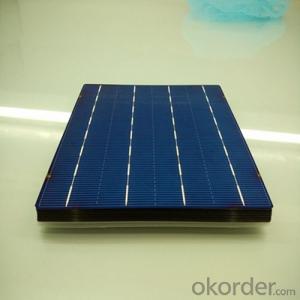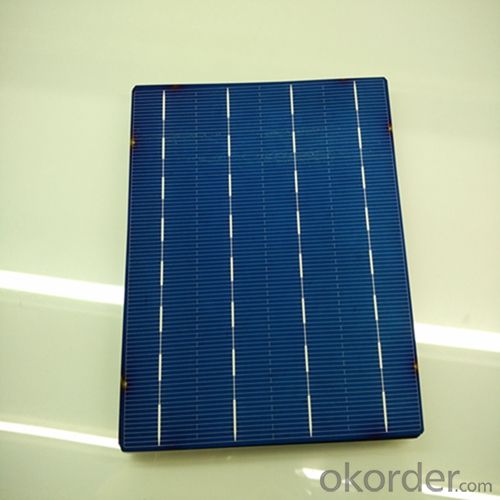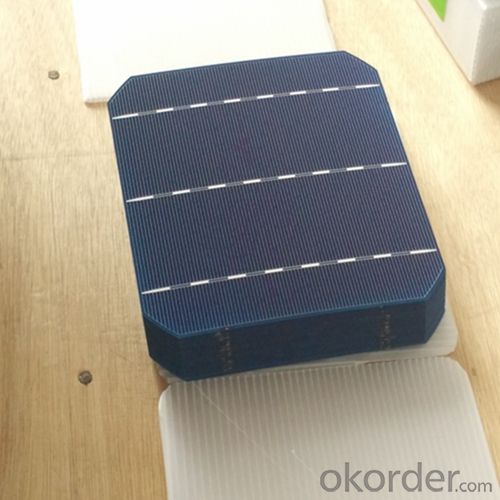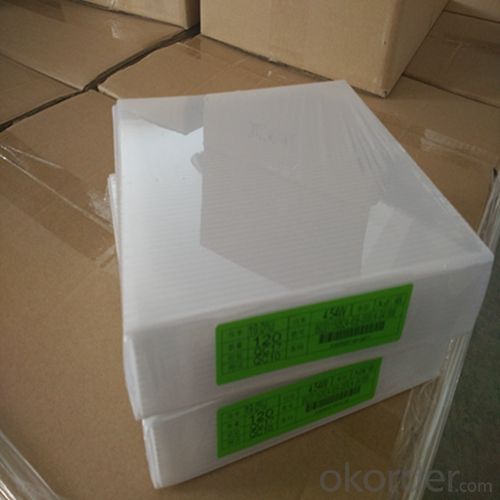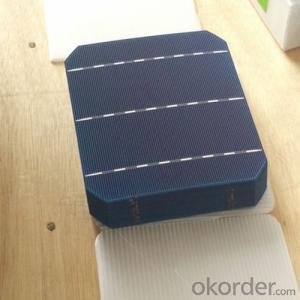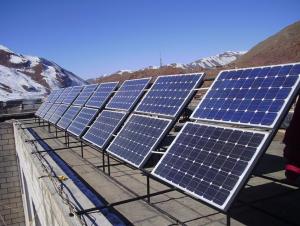Multijunction Solar Cells - Poly 156x156mm2 Class A Solar Cells
- Loading Port:
- Shanghai
- Payment Terms:
- TT OR LC
- Min Order Qty:
- 6500 watt
- Supply Capability:
- 6000000 watt/month
OKorder Service Pledge
OKorder Financial Service
You Might Also Like
The operation of a photovoltaic (PV) cell requires 3 basic attributes:
The absorption of light, generating either electron-hole pairs or excitons.
The separation of charge carriers of opposite types.
The separate extraction of those carriers to an external circuit.
In contrast, a solar thermal collector supplies heat by absorbing sunlight, for the purpose of either direct heating or indirect electrical power generation from heat. A "photoelectrolytic cell" (photoelectrochemical cell), on the other hand, refers either to a type of photovoltaic cell (like that developed by Edmond Becquerel and modern dye-sensitized solar cells), or to a device that splits water directly into hydrogen and oxygen using only solar illumination.Characteristic of Mono 156X156MM2 Solar Cells
You are gaining energy independence - add battery backup power for even greater energy security
The cost of electricity is only going to rise – insure against that rising cost
Adaptive cells change their absorption/reflection characteristics depending to respond to environmental conditions. An adaptive material responds to the intensity and angle of incident light. At the part of the cell where the light is most intense, the cell surface changes from reflective to adaptive, allowing the light to penetrate the cell. The other parts of the cell remain reflective increasing the retention of the absorbed light within the cell.[67]
In 2014 a system that combined an adaptive surface with a glass substrate that redirect the absorbed to a light absorber on the edges of the sheet. The system also included an array of fixed lenses/mirrors to concentrate light onto the adaptive surface. As the day continues, the concentrated light moves along the surface of the cell. That surface switches from reflective to adaptive when the light is most concentrated and back to reflective after the light moves along
Mechanical data and design
Format | 156mm x 156mm±0.5mm |
Thickness | 210μm±40μm |
Front(-) | 1.5mm bus bar (silver),blue anti-reflection coating (silicon nitride) |
Back (+) | 2.5mm wide soldering pads (sliver) back surface field (aluminium) |
Temperature Coefficient of Cells
Voc. Temp.coef.%/K | -0.35% |
Isc. Temp.coef .%/K | +0.024%/K |
Pm.Temp.coef. %/K | -0.47%/K |
Electrical Characteristic
Effiency(%) | Pmpp(W) | Umpp(V) | Impp(A) | Uoc(V) | Isc(A) | FF(%) |
18.35 | 4.384 | 0.526 | 8.333 | 0.63 | 8.877 | 78.39% |
18.20 | 4.349 | 0.526 | 8.263 | 0.63 | 8.789 | 78.54% |
18.05 | 4.313 | 0.525 | 8.216 | 0.63 | 8.741 | 78.32% |
17.90 | 4.277 | 0.524 | 8.161 | 0.625 | 8.713 | 78.04% |
17.75 | 4.241 | 0.523 | 8.116 | 0.625 | 8.678 | 77.70% |
17.60 | 4.206 | 0.521 | 8.073 | 0.625 | 8.657 | 77.36% |
17.45 | 4.170 | 0.519 | 8.039 | 0.625 | 8.633 | 76.92% |
17.30 | 4.134 | 0.517 | 8.004 | 0.625 | 8.622 | 76.59% |
17.15 | 4.096 | 0.516 | 7.938 | 0.625 | 8.537 | 76.80% |
17.00 | 4.062 | 0.512 | 7.933 | 0.625 | 8.531 | 76.18% |
16.75 | 4.002 | 0.511 | 7.828 | 0.625 | 8.499 | 75.34% |
16.50 | 3.940 | 0.510 | 7.731 | 0.625 | 8.484 | 74.36% |
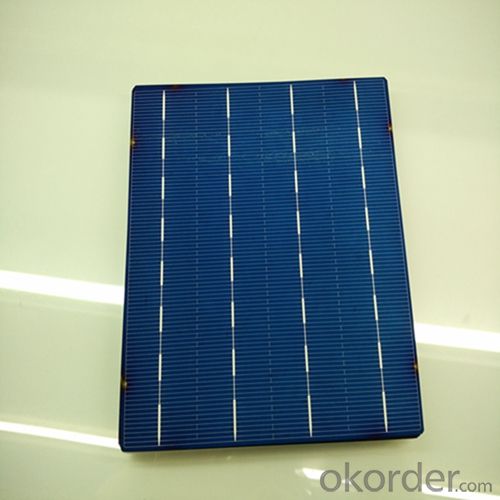
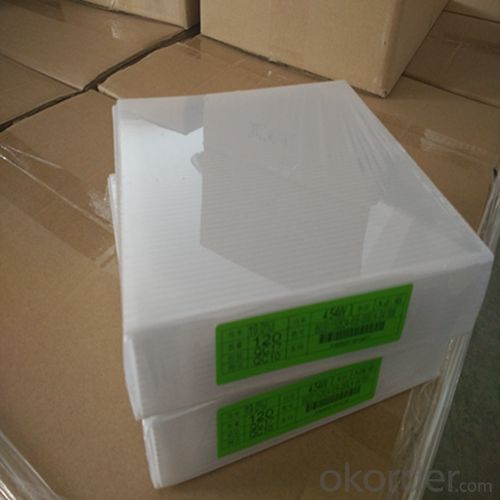
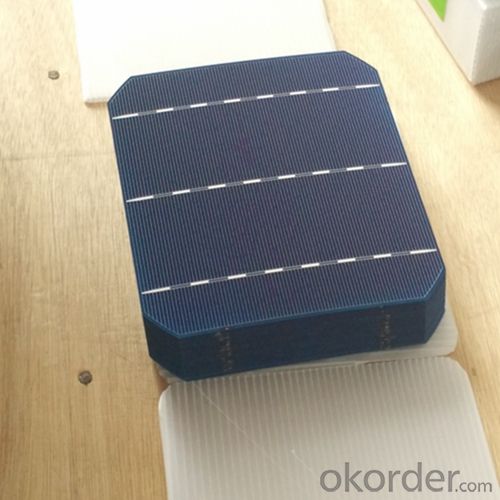
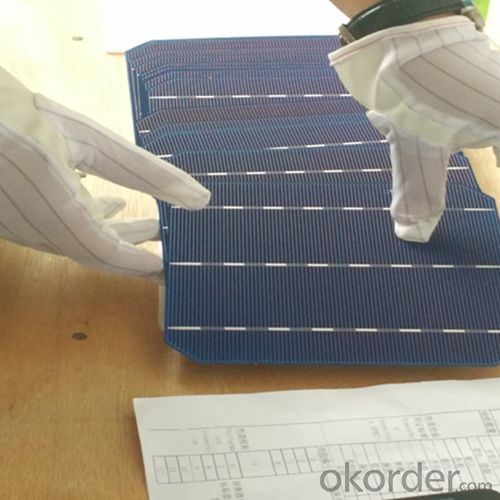
 FAQ
FAQ
Q: What price for each watt?
A: It depends on the quantity, delivery date and payment terms, generally Large Quantity and Low Price
Q: What is your size for each module? Can you tell me the Parameter of your module?
A: We have different series of panels in different output, both c-Si and a-Si. Please take the specification sheet for your reference.
Q: What is your size for each module? Can you tell me the Parameter of your module?
A: We have different series of panels in different output, both c-Si and a-Si. Please take the specification sheet for your reference.
- Q: Where can I buy the 156x156mm high efficiency poly solar cells assembly?
- You can always get it from the one of the biggest online trading website, which is www.alibaba
- Q: Can solar cells be used on airplanes?
- Yes, solar cells can be used on airplanes. In fact, solar-powered airplanes have been developed and successfully flown, demonstrating the feasibility of harnessing solar energy for aircraft propulsion. Solar cells can be integrated into the wings or body of the airplane to capture sunlight and convert it into electrical energy, reducing reliance on traditional fuel sources and making air travel more sustainable.
- Q: Can solar cells be used in aircraft applications?
- Yes, solar cells can be used in aircraft applications. They can be integrated into the structure of an aircraft to generate electricity from sunlight, which can power various onboard systems such as lighting, communication equipment, and navigation instruments. Additionally, solar cells can also be used to charge batteries in electric aircraft or unmanned aerial vehicles (UAVs), extending their flight time and reducing reliance on traditional fuel sources.
- Q: Can solar cells be combined with energy storage systems?
- Yes, solar cells can be combined with energy storage systems. This combination allows for the capture and storage of excess solar energy generated during periods of high sunlight, which can then be used during times when solar energy is not available. Energy storage systems help address the intermittent nature of solar power, ensuring a continuous and reliable energy supply.
- Q: How does the photovoltaic cells work?
- Simply put, a solar panel works by allowing photons, or particles of light, to knock electrons free from atoms, generating a flow of electricity.
- Q: Can solar cells be used in powering irrigation systems?
- Yes, solar cells can be used to power irrigation systems. Solar panels convert sunlight into electricity, which can be used to power pumps or other necessary components of irrigation systems. This offers a sustainable and cost-effective solution for providing power to irrigation systems in areas with limited access to electricity.
- Q: Is there any easy way to make a solar cell? I want to make a DIY solar cell with my child at home.
- A solar cell is converts sunlight into the power, in this way, you can just use the silicon.
- Q: How do solar cells perform in polluted environments?
- Solar cells can still generate electricity in polluted environments, but their performance can be negatively affected. Air pollution, such as smog or particulate matter, can block or scatter sunlight, reducing the amount of light that reaches the solar cells and therefore decreasing their efficiency. Additionally, the accumulation of dirt, dust, or pollutants on the surface of the solar panels can further reduce their performance by obstructing sunlight absorption. Therefore, regular cleaning and maintenance of solar panels are essential to optimize their performance in polluted environments.
- Q: Can solar cells be used for powering outdoor signage?
- Yes, solar cells can be used for powering outdoor signage. Solar cells convert sunlight into electricity, providing a sustainable and renewable energy source for outdoor signage systems. This eliminates the need for grid-connected electricity, reduces operational costs, and reduces the environmental impact.
- Q: What is the role of charge controllers in solar cell systems?
- The role of charge controllers in solar cell systems is to regulate the flow of electrical current between the solar panels and the batteries. They prevent overcharging of the batteries by monitoring the voltage and current levels, ensuring efficient charging and maximizing the lifespan of the batteries. Additionally, charge controllers protect the batteries from being drained excessively by disconnecting the load when the battery voltage drops to a certain level. Overall, charge controllers are crucial in maintaining the integrity and performance of solar cell systems.
Send your message to us
Multijunction Solar Cells - Poly 156x156mm2 Class A Solar Cells
- Loading Port:
- Shanghai
- Payment Terms:
- TT OR LC
- Min Order Qty:
- 6500 watt
- Supply Capability:
- 6000000 watt/month
OKorder Service Pledge
OKorder Financial Service
Similar products
Hot products
Hot Searches
Related keywords
